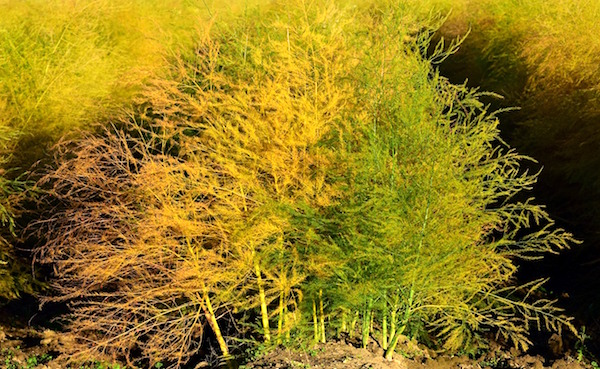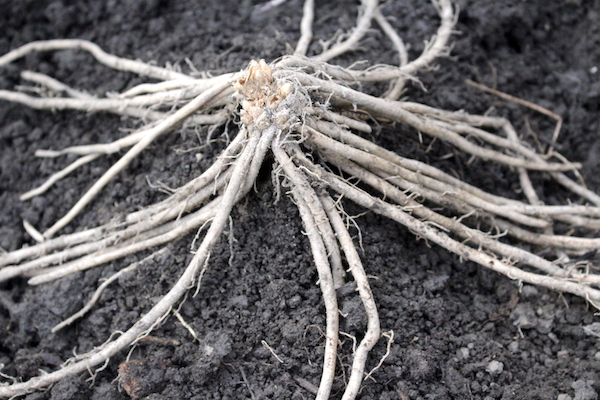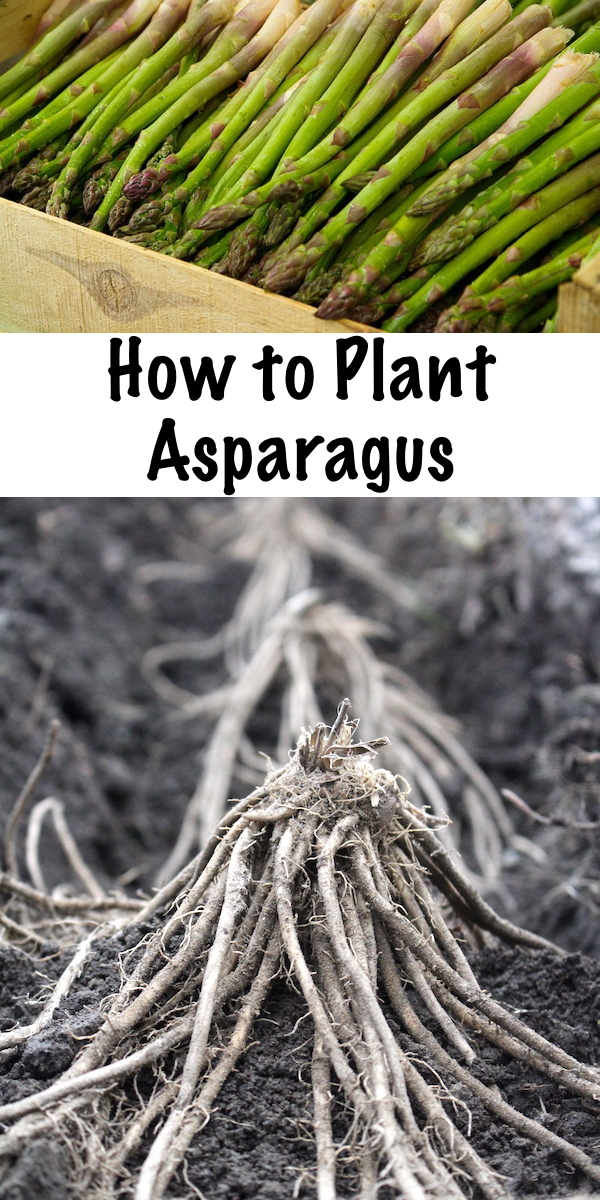Affiliate disclosure: This post may contain affiliate links. Please see our Privacy Policy.
Planting asparagus requires a good bit of advanced planning and soil preparation. Unlike most garden vegetables, asparagus plants are perennial and can produce for decades if properly tended.
Poorly planted or poorly tended patches may either be unproductive or wear out long before their time. Well planted asparagus beds, on the other hand, are low maintenance and can supply a family with tasty homegrown asparagus for a generation.

Planting Asparagus ~ Quick Start Guide
If you’re just looking for a quick refresher on how to plant asparagus, here are the basics:
- Hardiness Zones: 3 to 8
- Soil pH: 6.5 to 8 (slightly alkaline)
- Soil Requirements: Fertile, well-drained, deep soils and completely weed-free
- Planting Depth: 2 to 4 inches of soil above the top of the crown, but a trench 10-12 inches deep to accommodate all the roots (see notes later for specifics).
- Plant Spacing: 12 to 18 inches apart within a row, and then allow for at least 18 inches between rows within a bed (or 3 feet between rows if you want to walk between them).
- Years to First Harvest: Partial harvest in year 2, full harvest in year 3 and after.
Where to Plant Asparagus
Choosing a good location when planting asparagus is important because a patch can remain productive for 20+ years. That’s a long-term commitment, and you should consider your options carefully before planting.
Asparagus plants prefer fertile, well-drained soil that’s a bit alkaline (pH 6.5 to 8). They’ll actually do poorly if the pH is below 6, so keep them well away from acid-loving plants (like blueberries).
Since good drainage is important, consider planting asparagus in raised beds if you have heavy or clay soils. We grow our asparagus in log raised beds, and amend the soil with plenty of wood ash from our stove to correct the pH.
Asparagus plants send down deep roots, and it’s important to choose a planting location with deep soils. At a minimum, asparagus plants need at least 18 inches of fertile soil, preferably more to thrive.
Besides soil considerations, when planting asparagus it’s important to choose a location in full sun. Asparagus spears are harvested for about 6 weeks each spring and then the plants need to re-charge their reserves for the rest of the summer to ensure a good crop the following year.
Each plant will send up several 3-4′ tall fern-like fronds, and they’re actually quite beautiful, but they take up a lot of space. Be sure you’ve given them enough space to spread, as well as enough vertical space to reach full height.

When to Plant Asparagus
Generally, asparagus is grown from one-year crowns that are only available for purchase in the spring months. They’re usually planted in March and April, with colder locations planting asparagus considerably later than milder climates.
Once asparagus crowns are available, it’s safe to plant asparagus as soon as the soil can be worked in the spring and it’s dried out sufficiently from the snow thaw. There’s no need to wait until after the last spring frost, and early planting outdoors about 4 to 6 weeks before the last frost will ensure the plants get a good start on the growing season.
Though it’s less common, you can grow asparagus from seed as well. Seed grown asparagus is an economical way to start an asparagus patch, but the plants will take an extra year to reach maturity.
During their first year of growth, the seedlings will be developing a crown and strong roots. That’s why asparagus crowns are often called “1-year-old crowns,” because they give you a one year head start on the whole process.

Though the crowns are only available for purchase commercially in the spring, planting asparagus in the fall is also an option. If you have a friend or neighbor that wants to gift you a few asparagus crowns, wait until the plants have yellowed and begun to die back in the late fall.
Chop off the growing tops and carefully uproot the asparagus crowns. Planting asparagus crowns in the fall is the same as spring planting, but be sure to mulch new fall plantings with a few inches of well-rotted manure to protect them from winter weather as they get established.
How to Plant Asparagus
When planting asparagus, soil preparation is very important. Start by digging a trench that’s about 10 inches wide and 10 inches deep. Backfill the bottom 2-3 inches of the trench with well-rotted compost or manure.
Asparagus plants require a lot of fertility to thrive, and you only get one chance to put compost beneath the roots. Make sure you put plenty under there to ensure they’re well-fed in the long term.
Asparagus plants need to be planted at least 12 inches apart in a row, preferably 18 inches apart to allow for strong future growth. Once the trench is backfilled with well-rotted compost or mature, make use of a bit of the original soil from the trench to make small mounds every 12-18 inches. Drape the asparagus roots over the mound, fanning them out in all directions.

Each mound should be about 4 to 6 inches high, to bring the top of the asparagus crown to within 2 inches of the soil level outside the trench. Eventually, more soil will be added to bury the crowns even deeper, but in this first year, the tops should be just 2” deep until the spears emerge from the soil.
At this point, you should have a row of asparagus crowns, each crown resting over a mound of soil with its roots spread out in all directions. The asparagus crowns are 12 to 18 inches apart in the row and the tops of the crowns are about 2 inches below the surrounding soil level.

Once the first shoots emerge, add a bit more soil over the top to create a mounded row. Ideally, you should add about 2 more inches of fertile soil above each row, to create a bit of a mound. This helps bury the asparagus crowns a bit deeper, so they’ll end up about 4” below the soil surface. The slightly mounded soil also helps with drainage and helps keep the asparagus plants from sitting in soggy soil after heavy rains.
Here’s a quick recap…
- Start with a 10-inch trench
- Add 2 inches of compost (now it’s an 8” trench)
- Mound up 4-6” under each asparagus crown planting spot
- Place crowns on the mound, spread roots (crown tops are now 2” below soil level)
- Backfill in soil
- Allow asparagus to emerge and grow a few inches, then add about 2” more soil
How Long Until Harvesting Asparagus
So now that million dollar question…how long until the first asparagus harvest?
This first spring, right after planting asparagus, the plants are still getting established. I know it’s tempting, but they need every single one of those shoots this year. Next spring, you can harvest a small percentage of the spears for about 2 weeks. That little mini harvest is just enough to tide you over for a bit.
In the 3rd spring after planting asparagus, you can actually harvest for the full 6 week season. After 6 weeks, allow the spears to grow out fully and then leave the plants to gather energy for next year’s crop.





Hi Ashley. Thank you for a great site, full of info. I have a nice patch of deep sandy soil, next to a small river. We get occasional flooding of that area. Once or twice a year in winter. Water about 20cm deep, clears up after a day or three. Do you think I can plant asparagus there ?
You want to plant asparagus in well-drained soil. If it holds water for several days at a time I wouldn’t consider that to be well-drained.
I’m a newbie at growing asparagus and am fearing I planted my three-year-old crowns upside down. Should I dig ‘em up and flip-flop like a politician, or should I let them find sunlight on their own? I planted about ten days ago, and nothing is showing yet.
I would dig one up and verify that you have in fact planted them upside down. If that is the case then I would definitely dig them all up and plant them properly.
Thank you for the great information. This totally makes sense! Wish I knew this before I killed my first patch 🙁
You’re very welcome. I am sorry to hear about your first patch.
I’m wondering how or if asparagus can be divided. I planted about 15 crowns last year, and just ordered 50 more, but would love to be able to have some to give away. If they can be divided, is it advisable? I know daffodils get smaller and smaller, which is a sign that they are getting crowded. Does the same hold true with asparagus? Thanks for all you do.
Yes, you can and should divide your asparagus. According to this article from Mother Earth news, if you dig up an old patch of asparagus you will get enough plants to plant a patch even bigger than the original one. Plus, the old patch will produce more edible shoots after being thinned. https://www.motherearthnews.com/organic-gardening/tips-for-transplanting-asparagus-zmaz83sozshe
I have mine is a raised bed with rhubarb and horseradish and I noticed they seem to be “migrating”
can I dig them up to reposition? And if so, when should I do this?
Yes, you can dig up and reposition. You need to do it when they’re dormant, so in the fall after they’ve died back or in the early spring before they’ve started to grow again.
Does the asparagus need to be soaked before planting! The prongs look pretty dry. Thank you🥰
We don’t soak ours, but an hour of reviving time in water before planting probably would be beneficial if they’re quite dry.